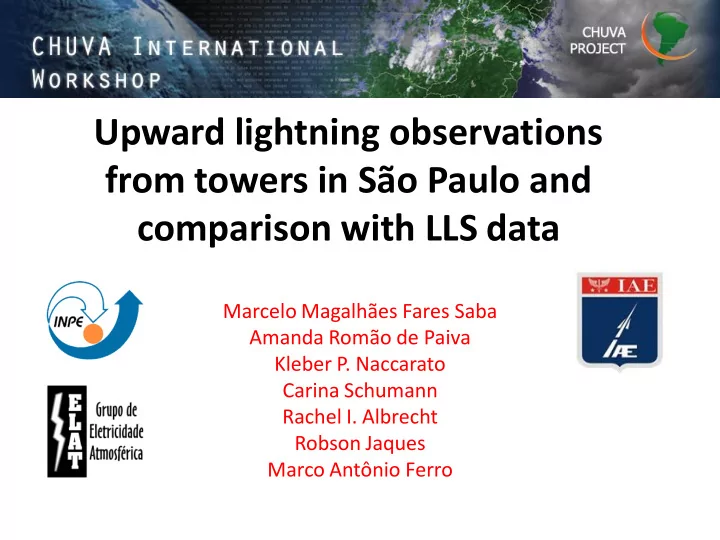

Upward lightning observations from towers in São Paulo and comparison with LLS data Marcelo Magalhães Fares Saba Amanda Romão de Paiva Kleber P. Naccarato Carina Schumann Rachel I. Albrecht Robson Jaques Marco Antônio Ferro
LLSs installed during CHUVA
Data from other World Wide LLS
Vaisala GLD 360
WWLLN (2008)
STARNET (2009)
ATDNET
Detection and Location of: • Leader initiation • Recoil leaders • M-component • Return strokes
Leader initiation
Recoil leaders Negative leaders retracing portions of + leader path
M-components During a luminous (current-carrying) channel connected to the tower
Return Strokes • No luminosity at all
Leader initiation 2 out of 15
Recoil leaders none
M-components 11 out of 38 During a luminous (current-carrying) channel connected to the tower
Return Strokes 4 out of 4
Detected Events LLS Leader M-component Recoil Return Total initiation Leaders Stroke TLS 200 LF 10 4 14 Rindat – IC Rindat - CG 3 3 6 BRASILDAT - IC 2 5 7 BRASILDAT- CG 3 2 5 LINET - IC 1 1 WWLLN GLD360 ATDNET STARNET HS video 15 38 100s 4
Why were some M-comp detected? Brasildat: -13 kA Brasildat: -16 kA TLS200: -22 kA TLS200: -27 kA Rindat: -20 kA Rindat: -25 kA
“non - impulsive” M -comp.
“Impulsive” M -comp.
RS and M-comp. waveforms
Location Accuracy (m) • RINDAT – CG 29,619 172 159 535 339 392
Location Accuracy (m) • BRASILDAT – IC 3,431 25,156 7,447 430 797 600
Location Accuracy (m) • BRASILDAT – CG 19,665 343 363 309 354 474
Location Accuracy (m) • TLS200 – LF 72 0 31 33 20 30 24 8,346 7,469 15 10 10 0 15
Location Accuracy (m) • LINET – IC 3,835
Summary • Return stroke is the process most detected in upward flashes. However their presence is scarce in upward flashes (1 flash out of 15). • Only impulsive M-components are detected. Most are not impulsive. • Most upward flashes are composed only by the initial continuous current which is not detected. • Therefore, detection of upward flashes is not trivial.
Recommend
More recommend